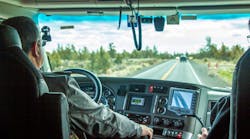A visit to the headquarters and terminal of Central Oregon Truck Company makes it easy to understand why the Truckload Carriers Association named it a “2018 Best Fleet to Drive For.” The 300 drivers have access to on-site dormitories, a gym, café, business center, and private bathrooms with showers professionally cleaned after every use. There is a 401K plan and an employee stock purchase through Daseke Inc.
In the view of CEO Rick Williams, that comes with the responsibility of being a professional. And just as an NFL quarterback reviews film with coaches after games, a similar process plays out every day at Central Oregon.
The company made the decision two years ago to install the SmartDrive video safety system across its fleet of 315 Kenworth trucks. It is used as a training tool, a way to exonerate drivers if falsely accused of an accident, and to help make decisions when they are in the wrong.
“If we do something wrong, we need to have that responsibility,” Williams said.
At Central Oregon, five coaches, led by Denny Kalista and Brad Aimone, are tasked with reviewing the videos, which are triggered by predetermined infractions. They then speak with that person to dissect what happened. It’s a relationship that begins even before a driver hauls the first load. This is part of the orientation process and allows coaches to correct potential problems before they form. It gives what Central Oregon considers a “more holistic” view of driver performance and, if needed, accident recreation.
“Every driver develops bad habits over time,” Williams said. “You can become complacent. This brings it to the forefront.”
Central Oregon is just one example of the growing number of trucking fleets that are bringing video into the fold.
In 2016, the National Transportation Safety Board recommended heavy truck and bus fleets use video recorder technology. It came after a study of more than 10,000 crashes estimated video could reduce fatal and injury crashes by 20% and 35%, respectively.
The price tag of these accidents adds up. The average cost is $11 million for a fatal accident, $500,000 for ones with injuries, and $75,000 for incidents that caused damage. In addition, out-of-cost settlements average $280,000—and often can be higher. Beyond the financial hit, accidents damage public perception and employee morale—and could also cost the trucker a job.
With so much at stake, it is little surprise that research firm Frost & Sullivan projects annual growth of more than 22%, bringing the number of vehicles with video-based systems to over one million by 2020.
Rob Abbott, commercial leader of enterprise trucking for Lytx, maker of the DriveCam video system, said a fleet trial could involve installing cameras in one out of every 20 trucks. That offers enough performance data to compare with other drivers while providing the opportunity for all to see the system up close and “dispel myths on how the system is used.”
In Central Oregon’s case, it started with a test of two trucks. From there, a video pilot program included 25 volunteers. Eventually, the decision was made to go fleet-wide with the SmartDrive system. Each tractor has one external- and one internal-facing camera. All drivers must use the external-facing camera, but some experienced drivers with safe driving records are allowed to opt out of using the internal one.
Pete Allen is chief client officer with MiX Telematics, which has 640,000 subscribers across a range of industries for its fleet solutions. That includes cameras that can be mounted externally to increase coverage around a vehicle. Regardless of whether it’s truckers or other drivers, he said it is crucial to be clear “how you intend to use this tool.” That includes when the cameras will never run, such as when in the sleeper berth.
Coming Tuesday in part 2: A look at how Central Oregon trains its new drivers.




